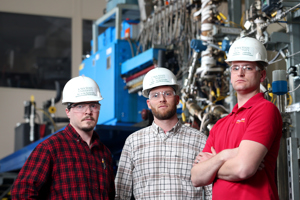Iowa State, Chevron team up to develop pilot plant, advance biofuel technology

The latest pilot plant at Iowa State’s BioCentury Research Farm is a joint project with Chevron. University engineers are using the pilot plant to develop and demonstrate an advanced biorenewables technology called solvent liquefaction. The technology converts biomass such as quarter-inch wood chips into a bio-oil that can be processed into fuels or chemicals and a biochar that can enrich soils.
The project is supported by a four-year, $3.5 MM grant from the US Department of Energy’s Biomass Research and Development Initiative, obtained by Iowa State.
The Chevron-Iowa State collaboration began in 2013 when the company moved its $1.4 MM Small Continuous Liquefaction Unit from Houston to the research farm just west of Ames. The company was looking for a research partner to develop the plant for continuous production and to build a system for recycling solvent back into the production process.
As part of the agreement, Chevron has donated the pilot plant to Iowa State.
“Our modular approach to the plant design allowed for a fair amount of prototyping and proof-of-concept experiments along the way,” said Martin Haverly, a doctoral student in mechanical engineering and the lead design engineer for the project. “The system is a blend of commercially available products and custom solutions, all tied together at an industrially relevant scale. All of these efforts helped us end up where we are now, with a safe and functioning pilot plant.”
“Chevron’s internal and university-partnered R&D activities have been very successful in obtaining fundamental knowledge that enabled us to rapidly climb the biofuels learning curve,” said Rick Powell, general manager of Downstream & Chemicals, Fuels and Products Strategy. “Programs such as the one with Iowa State help Chevron map the competitive landscape, deselect technically or economically unfeasible feedstock and technology options, and identify preferred paths for commercial collaboration.”
“This pilot plant is like a mini commercial system,” said Robert C. Brown, the director of the Bioeconomy Institute and an Anson Marston Distinguished Professor in Engineering. “A good pilot plant has all of the unit operations that take biomass to a product. It’s a big engineering challenge to tie all the steps together and have them operate in concert.”
The solvent liquefaction technology used in the pilot plant was initially developed by Chevron. The process begins with a proprietary solvent that’s mixed with wood chips or other solid biomass. The mixture is processed under moderate temperatures and pressures and the resulting slurry is extruded into a reactor.
After heating in the reactor, production is split into two processing streams: The upper handles gases and vapors, the lower handles liquids and small amounts of solids. A series of filters and separators along both streams recovers bio-oil, small amounts of biochar and solvent for recycling.
The process produces a bio-oil that is low in oxygen and therefore more stable than other bio-oils.
“With the work Chevron did, this looked like it could be a very cost-effective method for producing biofuels,” said Ryan Smith, the deputy director of the Bioeconomy Institute’s Thermochemical Research Group. “But many of the unit operations hadn’t been tested, so the team has been working to design and optimize these operations.”
Lysle Whitmer, Sr. Research Engineer at Iowa State University, said the engineers have now demonstrated the viability of every one of the pilot plant’s operations. They’re still working to efficiently and simultaneously run all the operations.
The pilot plant operates about once a week, Whitmer said. It can process about a pound of biomass every hour and typically runs for 15 to 18 hours at a time.
Brown said the project’s next steps could include working with new feedstocks to create high-value, biorenewable chemicals.
Project leaders said they’re pleased with the pilot plant’s progress so far.
“Our collaboration with Chevron has been extremely productive,” Brown said. “Our previous experience in thermochemical processing of biomass combined with Chevron’s expertise in process engineering and upgrading of oils has allowed us to meet the several challenges of developing a new technology.”






Comments